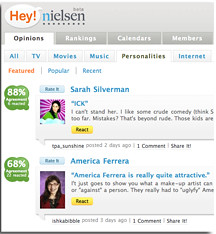It’s true. I’ve never been a Facebook fan. I maintain an
account because some people I know like it, but I have never felt “fully migrated” along with the rest of my fellow social network
nomads.
Dark cloud coverage every few weeks seems to reaffirm my one toe in approach: the Beacon
fiasco, the
business bans, the negative
cash flow , and on, and on.
However, every now and again, there seems to be a silver lining that comes in the form of a third-party widget. The addition of a Twitter feed was one. And now, SeenThis? by Loomia is another.
SeenThis? by Loomia The value seems to be much deeper than the launch partners who dominated the early buzz last week. Having The Wall Street Journal Online (WSJ), NBC Universal, and CNET Networks as partners is certainly news, but
SeenThis?, which allows social network members to share what they read via Facebook, is a well thought out application that adds real value to the online experience.
The original concept was simple enough. David Marks, co-founder and CTO, along with the rest of the Loomia team, wanted to create a social network tool that mimicked personal social patterns in real life and used recommendation applications they have already provide to many sites.
“When people see a movie or read a good article, they share it with friends and co-workers,” said Marks. “We wanted to bring this online, helping them ‘stay in the know’ with friends, groups and networks.”
Simply stated, the new Facebook application tracks articles that you and your friends, group members, and network members read, allowing you to see what articles might be popular. For example, three of my Facebook groups found some interest in the WSJ article “
Google Aims to Crack China With Music Push” so I decided to take a look.
Once there, I skimmed the article and also noticed that WSJ’s publisher version of the application lists other related stories, new stories, popular stories, and — which is very cool — other WSJ stories that my friends, groups, or networks found interesting, like the “
Mac Ad You Will Never See."
Even better, to make SeenThis? work as combination convergence and recommendation tool, all of the data was collected anonymously. It will remain anonymous unless you specifically choose to share a particular article link with selected Facebook friends (whether they have added the SeenThis? widget or not).
In some ways, it's like having your own mini-Digg site, except it's confined to your networks and much more passive in gaging interest among selected publishers. You and your friends interest in a subject is dependent on what you read, not what you group vote up or down.
SeenThis? Will Move Beyond FacebookIn the near future, SeenThis? will not be confined to a Facebook application. It will be deployable on other social networks. Marks tells me that MySpace (which recently opened its platform to developers) and OpenSocial are likely to be the next.
Facebook was first, primarily because of its very friendly API development platform, he said. But the vision driving SeenThis? goes well beyond a single social network. And that is part of its charm.
As new social networks are added, SeenThis? will compile the data across all of these networks, allowing subscribers to track popular content across as many or as few as they want. Likewise, people using SeenThis? can pick and choose from 18 content providers (and growing), including: partners like CNET, NBC, and WSJ and publishers like TechCrunch, Slate, and The Economist. One of the newest content additions is College Humor, which was added after people already using the widget asked Loomia to do so.
In addition to compiling data as a convergence tool, SeenThis? makes it easy to scan headlines from multiple publications. This seems especially useful for bloggers who want to tailor their posts to media stories that their social networks and friends already find interesting. Bloggers can add a Loomia widget to their blogs as well. While I don't believe it will be included in the SeenThis? feeds (publisher feeds can be), the widget will add recommended articles based on blog content.
The application is
free, provided you choose the ad-supported version by Loomia. There are other versions with a tiered pricing structure as well.
SeenThis? And PrivacyData collection always raises privacy flags, especially when it is related to Facebook. However, SeenThis? has taken several steps to keep any data collected completely anonymous, including expirations on how long this data is stored.
“SeenThis? users have complete control over how they share information,” Marks said. “They remain completely anonymous unless they share a story (send a link) to their friends.”
Marks said that most research, including Loomia’s own, shows that people want to know what their friends, groups, and networks are reading, but no one really wants to share everything they read. By collecting and pooling data among anonymous users who have opted in, SeenThis? networkers will enjoy the best of both worlds.
SeenThis? May Set The Next WaveAccording to Marks, SeenThis? will be added to an increasing number of social networks soon, and users will be able to employ it in some interesting ways: discussions can be created around popular content and articles; users will be able to opt in to receive select notifications; and you can always control which publishers appear on your site or social network page.
To me, it really demonstrates that there are widgets, and then there are
widgets. Loomia seems to have created the latter, tapping into the growing online social awareness . It’s relevant and useful, perhaps one of the most responsive applications built around the people who will use it.
It is also intuitive in that there is a new social layer being developed as social networks open up their platforms. Developers like Loomia are looking for new ways to manage portable groups and content. Marks says we can expect to see more applications like this in the near future. I think he’s
right.





































